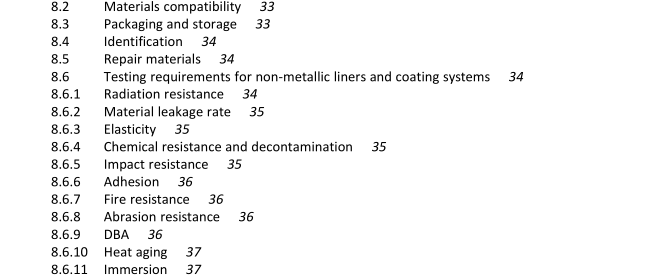CSA N287.2-17 pdf download – Material requirements for concrete containment structures for nuclear power plants.
3 Definitions The following definitions shall apply in this Standard: Anchor — a steel element cast into concrete or post-installed into a hardened concrete member and used to transmit applied forces. Note: Examples include straight bolts, hooked bolts (J- or L-bolts), headed studs, expansion anchors, undercut anchors, and inserts. Anchor channels — steel profile with rigidly connected anchors embedded in its final location at the time of concrete placing. [Source: ICC-ES AC 232] Note: Historically, anchor channels were called embedded inserts. Anchorage system — the combined materials designed to provide anchorage to concrete for support of equipment or components in their final position. Authority having jurisdiction (AHJ) — the organization having jurisdiction over the design, procurement, fabrication, installation, testing, operation, inspection, maintenance, and decommissioning of a nuclear facility. Notes: 1) AHJ is also referred to as “regulatory authority”.
Cast-in anchor — a headed or hooked bolt installed before concrete is placed. Coating system — a protective layer applied on the base substrate, concrete or steel, in a qualified manner to meet the design requirements and to protect the substrate from environmental degradation. Containment boundary — the containment structure and related components that provide a pressure- retaining barrier to prevent or limit the escape of any radioactive matter released from reactor processes. Containment components — the metallic and non-metallic portions of the containment boundary that are not parts of the containment structure. Containment structure — the structural portion of the containment boundary. Containment system — the arrangement of structure, systems, and components that prevent or limit the escape of radioactive substances when such substances are released from reactor process systems. Embedded part — a part that is in its final location at the time of concrete placing and is permanently anchored in the concrete structure. Note: Embedded parts are generally either a) penetrations that provide openings through the concrete structure for the passage of personnel, material, process piping, ducts, and cables; or b) non-penetrations that are used primarily as a means of supporting items such as platforms, equipment, and piping in the concrete structure or for the protection of the concrete. Engineer — a person in the engineering profession who has specific expertise in concrete containment and is licensed by the professional association having jurisdiction. Note: The engineer can be a designated representative of the operating organization. Expansion anchor — a post-installed anchor inserted into hardened concrete that transfers loads into the concrete by direct bearing or friction, or both. Note: Expansion anchors are classified under the following two groups: a) torque-controlled — an expansion anchor that achieves expansion by a torque acting on the screw or bolt;
Liner — a metallic or non-metallic membrane on a containment boundary to provide or enhance leak- tightness. Mass concrete — any volume of concrete with dimensions large enough to require that measures be taken to cope with the generation of heat from hydration of cement and attendant volume change to minimize cracking. [Source: ACI 207.1] Mechanical splice — a device for making in-line connections between reinforcing bars, or for joining a reinforcing bar to a steel part for the purpose of transmitting tensile and/or compressive forces. Note: Generally, a steel sleeve is joined to the reinforcing bar by means of threading, filler material, or swaging bolts. Non-metallic liner — a continuous rigid or elastic membrane that, is applied on a substrate to enhance leak tightness. Note: Typical non-metallic liners include a) liquid applied liners: urethane, cementitious, latex-modified, and epoxy; and b) sheet liners: polyvinyl, neoprene, butyl, and rubber. Elastic liner — a continuous membrane that, when applied on a substrate, remains ductile after curing and has a crack spanning capability for the specified service life. Rigid liner — a continuous non-metallic membrane that, when applied on a substrate, hardens after curing to form a non-ductile surface for which limited strain damage can be tolerated in the application.
CSA N287.2-17 pdf download.
